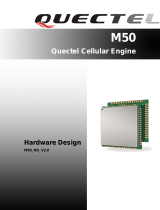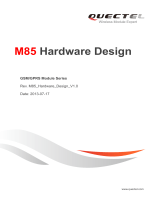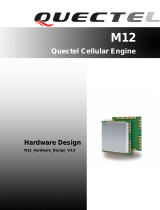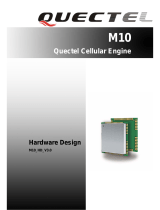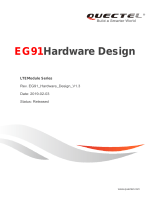Page is loading ...

SIM7020 _Hardware Design_V1.02

Smart Machine Smart Decision
SIM7020_Hardware_Design_V1.02 1 2018-07-25
Document Title SIM7020 _Hardware Design
Version 1.02
Date 2018-07-25
Status Release
Document Control ID SIM7020 _ Hardware Design_V1.02
General Notes
SIMCom offers this information as a service to its customers to support the application and
engineering efforts that use the products designed by SIMCom. The information provided is based
on the requirements specifically from the customers. SIMCom has not undertaken any independent
search for additional relevant information, including any information that may be in the customer’s
possession. Furthermore, the system validation of the product designed by SIMCom within a larger
electronic system remains the responsibility of the customer or the customer’s system integrator.
All specifications supplied herein are subject to change without notice.
Copyright
This document contains the proprietary technical information which is the property of SIMCom
Limited, copying of this document, giving it to others, the using or communication of the contents
thereof are forbidden without the official authority by SIMCom. Offenders are liable to the
payment of the damages. All rights are reserved in the event of grant of a patent or the registration
of a utility model or design. All specifications supplied herein are subject to change without notice
Copyright © SIMCom Wireless Solutions Co., Ltd. 2018

Smart Machine Smart Decision
SIM7020_Hardware_Design_V1.02 2 2018-07-25
Contents
Contents .............................................................................................................................................2
Table Index ........................................................................................................................................4
Figure Index ......................................................................................................................................5
1 Introduction ................................................................................................................................7
1.1 Product Outline .....................................................................................................................7
1.2 Hardware Interface Overview ...............................................................................................7
1.3 Hardware Block Diagram......................................................................................................7
1.4 Functional Overview .............................................................................................................8
2 Package Information................................................................................................................10
2.1 Pin Assignment Overview ...................................................................................................10
2.2 Pin Description .................................................................................................................... 11
2.3 Mechanical Information ......................................................................................................14
2.4 Footprint Recommendation .................................................................................................15
3 Interface Application ...............................................................................................................16
3.1 Power Supply ......................................................................................................................16
3.2 Power Supply Design Guide ...............................................................................................16
3.3 Voltage Monitor...................................................................................................................17
3.4 Power on/Power off/Reset Function ....................................................................................17
3.4.1 Power on .......................................................................................................................17
3.4.2 Power off ......................................................................................................................19
3.4.3 Reset Function ..............................................................................................................20
3.5 UART Interface ...................................................................................................................21
3.5.1 UART Design Guide ....................................................................................................21
3.5.2 RI and DTR Behavior ...................................................................................................23
3.6 USB Interface ......................................................................................................................23
3.7 SIM Interface ......................................................................................................................24
3.7.1 SIM Application Guide ................................................................................................24
3.7.2 Recommended SIM Card Holder .................................................................................25
3.8 Network status .....................................................................................................................26
3.9 ADC ....................................................................................................................................26
3.10 Power Supply Output .......................................................................................................27
4 RF Specifications ......................................................................................................................29
4.1 LTE RF Specifications ........................................................................................................29
4.2 LTE Antenna Design Guide ................................................................................................30
4.3 RF traces note ......................................................................................................................31
4.3.1 RF traces layout ............................................................................................................31
4.3.2 LTE ANT and other system ANT decoupling ..............................................................33
5 Electrical Specifications ...........................................................................................................34
5.1 Absolute maximum ratings .................................................................................................34
5.2 Operating conditions ...........................................................................................................34

Smart Machine Smart Decision
SIM7020_Hardware_Design_V1.02 3 2018-07-25
5.3 Operating Mode ..................................................................................................................35
5.3.1 Operating Mode Definition ..........................................................................................35
5.3.2 Sleep mode ...................................................................................................................36
5.3.3 Minimum functionality mode and Flight mode ............................................................36
5.3.4 Power Saving Mode (PSM) ..........................................................................................37
5.3.5 Extended Mode DRX (e-DRX) ....................................................................................37
5.4 Current Consumption ..........................................................................................................37
5.5 ESD Notes ...........................................................................................................................38
6 SMT Production Guide ............................................................................................................39
6.1 Top and Bottom View of SIM7020 .....................................................................................39
6.2 Typical SMT Reflow Profile ...............................................................................................39
6.3 Moisture Sensitivity Level (MSL) ......................................................................................40
6.4 Baking Requirements ..........................................................................................................40
6.5 Stencil Foil Design Recommendation .................................................................................41
7 Packaging ..................................................................................................................................42
8 Appendix ...................................................................................................................................44
8.1 Related Documents .............................................................................................................44
8.2 Terms and Abbreviations .....................................................................................................46
8.3 Safety Caution .....................................................................................................................48
Contact ............................................................................................................... 错误!未定义书签。

Smart Machine Smart Decision
SIM7020_Hardware_Design_V1.02 4 2018-07-25
Table Index
Table 1: SIM7020 frequency bands and air interface .................................................................7
Table 2: General features ............................................................................................................8
Table 3: Pin definition ............................................................................................................... 11
Table 4: IO parameters definition ............................................................................................. 11
Table 5: Pin description ............................................................................................................12
Table 6: VBAT pins electronic characteristic ............................................................................16
Table 7: Recommended TVS diode list ....................................................................................17
Table 8: Power on timing and electronic characteristic ............................................................18
Table 9: Power off timing and electronic characteristic ............................................................19
Table 10: RESET pin electronic characteristic .........................................................................20
Table 11: Recommended TVS list ............................................................................................23
Table 12: SIM electronic characteristic in 1.8V mode (SIM_VDD=1.8V) ..............................24
Table 13: SIM electronic characteristic 3.0V mode (SIM_VDD=3V)......................................24
Table 14: Amphenol SIM socket pin description ......................................................................26
Table 15: NETLIGHT pin status ...............................................................................................26
Table 16: ADC electronic characteristics ..................................................................................27
Table 17: Electronic characteristic ............................................................................................27
Table 18: Conducted transmission power .................................................................................29
Table19: Maximum Power Reduction (MPR) for UE category NB1 Power Class 3 ...............29
Table 20: E-UTRA operating bands ..........................................................................................29
Table 21: CAT-NB1 Reference sensitivity (QPSK) ..................................................................30
Table 22: Trace loss ..................................................................................................................30
Table 23: Recommended TVS ..................................................................................................31
Table 24: Absolute maximum ratings .......................................................................................34
Table 25: Recommended operating ratings ...............................................................................34
Table 26: 1.8V Digital I/O characteristics* ...............................................................................34
Table 27: Operating temperature ...............................................................................................35
Table 28: Operating mode Definition .......................................................................................35
Table 29: RTC_GPIO0/RTC_EINT characteristics ..................................................................37
Table 30: Current consumption on VBAT Pins (VBAT=3.3V) .................................................37
Table 31: The ESD performance measurement table ................................................................38
Table 32: Moisture Sensitivity Level and Floor Life ................................................................40
Table 33: Baking requirements .................................................................................................40
Table 34: Tray size ....................................................................................................................42
Table 35: Small Carton size ......................................................................................................43
Table 36: Big Carton size ..........................................................................................................43
Table 37: Related Documents ...................................................................................................44
Table 38: Terms and Abbreviations ...........................................................................................46
Table 39: Safety Caution ...........................................................................................................48

Smart Machine Smart Decision
SIM7020_Hardware_Design_V1.02 5 2018-07-25
Figure Index
Figure 1: SIM7020 block diagram ..............................................................................................8
Figure 2: Pin assignment overview ...........................................................................................10
Figure 3: Dimensions (Unit: mm) .............................................................................................14
Figure 4: Footprint recommendation (Unit: mm) .....................................................................15
Figure 5: Power supply application circuit ...............................................................................17
Figure 6: Reference power on/off circuit ..................................................................................18
Figure 7: Power on timing sequence .........................................................................................18
Figure 8: Power off timing sequence ........................................................................................19
Figure 9: Reference reset circuit ...............................................................................................20
Figure 10: UART full modem ...................................................................................................21
Figure 11: UART null modem ..................................................................................................21
Figure 12: Reference circuit of level shift ................................................................................22
Figure 13: TX level matching circuit ........................................................................................22
Figure 14: RX level matching circuit ........................................................................................22
Figure 15: RI behaviour (SMS and URC report) .................................................................23
Figure 16: USB reference circuit ..............................................................................................23
Figure 17: SIM interface reference circuit ................................................................................25
Figure 18: Amphenol SIM card socket .....................................................................................25
Figure 19: NETLIGHT reference circuit ..................................................................................26
Figure 20:Power on sequence of the VDD_EXT ...................................................................27
Figure 21:Power on sequence of the VDD_3V3 ....................................................................27
Figure 22: Antenna matching circuit (MAIN_ANT) ................................................................31
Figure 23: RF trace should be far away from other high speed signal lines .............................32
Figure 24: The distance between GND to the inner conductor of SMA ...................................32
Figure 25: Top and bottom view of SIM7020 ...........................................................................39
Figure 26: The ramp-soak-spike reflow profile of SIM7020 ....................................................39
Figure 27: Recommended SMT stencil footprint outline ..........................................................41
Figure 28: packaging diagram ..................................................................................................42
Figure 29: Tray drawing............................................................................................................42
Figure 30: Small carton drawing ...............................................................................................43
Figure 31: Big carton drawing ..................................................................................................43

Smart Machine Smart Decision
SIM7020_Hardware_Design_V1.02 6 2018-07-25
Revision History
Data Version Description of change Author
2018-02-07 1.00 Original Ya.li
Ming.zhu
2018-04-19 1.01
Update figure 1,9,20,21
Update table 2,8,9,10,16, 29,30
Update chapter 3.5.1
Add chapter 3.5.4, 3.5.5
Add table 28
Ming.zhu
2018-07-25 1.02
Update figure 1
Update table 2,6,21,30
Ya.li
Ming.zhu

1 Introduction
This document describes SIM7020 hardware interface in great detail. The document can help
customer to quickly understand SIM7020 interface specifications, electrical and mechanical details.
With the help of this document and other SIM7020 application notes, customer guide, customers can
use SIM7020 to design various applications quickly.
1.1 Product Outline
The SIM7020 series modules support LTE CAT-NB1.
With a tiny configuration of 17.6*15.7*2.3mm, SIM7020 can meet almost all the space requirements
in customers’ applications, such as smart phone, PDA and other mobile devices. And the physical
dimension is compatible with the packaging of SIM800C.
Table 1: SIM7020 frequency bands and air interface
Standard
Freque
ncy
Variants
SIM7020C SIM7020E
HD-FDD
B1
B3
B5
B8
B20
B28
1.2 Hardware Interface Overview
The interfaces are described in detail in the next chapters include:
Power Supply
USB Interface
UART Interface
SIM Interface
ADC
Power Output
GPIOs
Antenna Interface
1.3 Hardware Block Diagram
The block diagram of the SIM7020 module is shown in the figure below.

Smart Machine Smart Decision
SIM7020_Hardware_Design_V1.02 8 2018-07-25
Figure 1: SIM7020 block diagram
1.4 Functional Overview
Table 2: General features
Feature
Implementation
Power supply
Power supply voltage 2.1
~
3.6V,Typ=3.3V
Power saving Current in sleep mode: 236uA (at+cfun=0)
Current in PSM mode: 3.4uA
Radio frequency bands
Please refer to the table 1
Transmitting power LT E 23dBm
Data Transmission
Throughput
LT E CAT NB1: 26.15Kbps (DL)
LTE CAT NB1: 62.5Kbps (UL)
Antenna LTE antenna.
SMS MT, MO, Text and PDU mode
SIM interface Support identity card: 1.8V/ 3V
UART1 interface
A full modem serial port by default
Baud rate: default:115200bps
Can be used as the AT commands or data stream channel

Smart Machine Smart Decision
SIM7020_Hardware_Design_V1.02 9 2018-07-25
Support RTS/CTS hardware handshake
UART2 interface Baud rate: default:115200bps
Can be used for debugging and upgrading firmware
USB USB 1.1 interface for debugging
(Log port can be selected by AT
command.)
Firmware upgrade Firmware upgrade over UART2 interface
Physical characteristics
Size: 17.6*15.7*2.3mm
Weight: 1.3g±0.2g
Temperature range
Normal operation temperature: -30°C to + 80°C
Extended operation temperature: -40°C to + 85°C*
Storage temperature -45°C to + 90°C
*Note: The performance will be reduced slightly from the 3GPP specifications if the temperature
is outside the normal operating temperature range and still within the extreme operating
temperature range.

Smart Machine Smart Decision
SIM7020_Hardware_Design_V1.02 10 2018-07-25
2 Package Information
2.1 Pin Assignment Overview
2
3
4
5
6
7
8
9
10
11
12
1
UART1_TXD
UART1_RXD
UART1_RTS
UART1_CTS
UART1_DCD
UART1_DTR
UART1_RI
GND
VDD_3V3
GPIO0
RTC_GPIO0
RTC_EINT
14
15
16
17
18
19
20
21
13
GND
SIM_DET
SIM_DATA
SIM_CLK
SIM_RST
SIM_VDD
GND
NC
GND
35
36
37
38
39
40
41
42
34
VBAT
STATUS
NETLIGHT
VDD_EXT
PWRKEY
ADC
GND
GND
VBAT
33
32
31
30
29
28
27
26
25
24
23
22
GND
ANT
GND
GND
GPIO1
RESET
GND
USB_DM
USB_DP
USB_VBUS
UART2_RXD
UART2_TXD
SIM7020
TOP VIEW
Figure 2: Pin assignment overview

Smart Machine Smart Decision
SIM7020_Hardware_Design_V1.02 11 2018-07-25
Table 3: Pin definition
Pin No. Pin Name Pin No. Pin Name
1 UART1_TXD 22 UART2_TXD
2 UART1_RXD 23 UART2_RXD
3
UART1_RTS
24
USB_VBUS
4
UART1_CTS
25
USB_DP
5
UART1_DCD
26
USB_DN
6
UART1_DTR
27
GND
7 UART1_RI 28 RESET
8 GND 29 GPIO1
9 VDD_3V3 30 GND
10 GPIO0 31 GND
11 RTC_GPIO0 32 ANT
12 RTC_EINT 33 GND
13 GND 34 VB AT
14 SIM_DET 35 VB AT
15 SIM _D ATA 36 GND
16 SIM_CLK 37 GND
17 SIM_RST 38 ADC
18 SIM_VDD 39 PWRKEY
19
GND
40
VDD_EXT
20
NC
41
NETLIGHT
21 GND 42 S TAT U S
2.2 Pin Description
Table 4: IO parameters definition
Pin type Description
PI
Power input
PO
Power output
AI
Analog input
AIO
Analog input/output
I/O
Bidirectional input /output
DI
Digital input
DO
Digital output
DOH
Digital output with high level
DOL
Digital output with low level
PU
Pull up

Smart Machine Smart Decision
SIM7020_Hardware_Design_V1.02 12 2018-07-25
PD
Pull down
Table 5: Pin description
Pin name Pin No.
Default
status
Description Comment
Power supply
VB AT 34 、
3
PI
Power supply, voltage range:
2.1
-
3.6V.
VDD_EXT 40 PO
Power output 1.8V for other
external circuits with Max
50mA current output, such as
level shift circuit. Not present in
PSM mode.
If unused, keep it open.
VDD_3V3 9 PO
Power output 3.3V for other
external circuits with Max
50mA current output. Not
present in PSM mode.
Voltage range
3.3V-3.5V( depend on
VBAT). If unused,
keep it open.
GND
8、
19 、
2
、27、 3
0
、
33 、
3
、37
Ground
System Control
PWRKEY 39 DI,PU
System power on/off control
input, active low. The efficient
input level must be below 0.5V.
PWRKEY has been
pulled up to V BAT via
40Kohm resistor
internally.
RESET 28 DI,PU System reset control input,
active low.
RESET has been
pulled up to V BAT via
40Kohm resistor
internally.
SIM interface
SIM _ D ATA 15 I/O,PU SIM Card data I/O
All lines of SIM
interface should be
protected against ESD.
SIM_RST 17 DO SIM Reset
SIM_CLK 16 DO SIM clock
SIM_VDD 18 PO
Power output for SIM card, its
output Voltage depends on SIM
card type automatically. I
SIM_DET
14 DI
SIM card detecting input. (This
function do not support yet in
standard software.)
If used, keep a 10kΩ
resistor pulling up to
the VDD_EXT

Smart Machine Smart Decision
SIM7020_Hardware_Design_V1.02 13 2018-07-25
USB
USB_VBUS 24 DI,PD Valid USB detection input with
2.5~5.25V detection voltage
USB interface for
debugging
USB_DP 25 I/O
Positive line of the differential,
bi-directional USB signal.
USB_DN 26 I/O Negative line of the differential,
bi-directional USB signal.
UART interface
UART1_TXD 1 DOH Transmit Data
If unused, keep them
open.
UART1_RXD 2 DI,PU Receive Data
UART1_RTS
3
DI
,
PU
Request to send
UART1_CTS
4
DOH
Clear to Send
UART1_DCD 5 DOH Data carrier detect
UART1_DTR 6 DI,PU Transmit Data
UART1_RI
7
DOH
Ring Indicator
UART2_TXD
22
DOH
Transmit Data
UART2_RXD
23
DI
,
P
Receive Data
Indicate and Control in PSM Mode
RTC_GPIO0 11 DO
In PSM, RTC_GPIO0 will
change state from low to high if
RTC_EINT receive interrupt
event.
Voltage Domain:
VB AT
RTC_EINT 12 DI 、
P
RTC_EINT can be the wake up
source for exiting PSM.
GPIO
NETLIGHT 41 DO
LED control output as network
status indication.
If unused, keep them
open.
S TAT U S 42 DO
Operating status output.
High level: Power on and
firmware ready
Low level: Power off
GPIO0 10 IO
Do not pull down before power
on
GPIO1 29 IO
RF interface
ANT 32 AI antenna
Other interface
ADC 38 AI
Analog-digital converter input.
Voltage range: 0.1
-
1.4V.
If unused, keep them
open.
NC 20 No connection. Keep it open

2.3 Mechanical Information
The following figure shows the package outline drawing of SIM7020.
Figure 3: Dimensions (Unit: mm)

Smart Machine Smart Decision
SIM7020_Hardware_Design_V1.02 15 2018-07-25
2.4 Footprint Recommendation
Figure 4: Footprint recommendation (Unit: mm)

Smart Machine Smart Decision
SIM7020_Hardware_Design_V1.02 16 2018-07-25
3 Interface Application
3.1 Power Supply
The power supply for SIM7020 must be able to provide sufficient current up to more than 500mA
in order to satisfy the power supply current for maximum consumption.
Table 6: VBAT pins electronic characteristic
Symbol
Description
Min.
Typ.
Max.
Unit
VB AT Module power voltage 2.1 3.3 3.6 V
I
VBAT(peak)
Module power peak current in NB emission 500 - - mA
I
VBAT(average)
Module power average current in normal mode Please refer to the table 32
IVBAT(sleep) Power supply current in sleep mode
IVBAT(PSM) Power supply current in PSM mode - 3.4 - uA
IVBAT(power-of
f)
Module power current in power off mode. - - 12 uA
3.2 Power Supply Design Guide
Make sure that the voltage on the VBAT pins will never drop below 2.1V, or module will be work
abnormally.
Note: If the power supply for VBAT pins can support up to500mA, using a total of more than
100uF capacitors is recommended, or else users must using a total of 300uF capacitors typically,
in order to avoid the voltage drop. The module power peak current depends on the total
capacitance. Using a total of 1000uF capacitors in the test that will reduce the peak current to
320mA.
The following figure shows the recommended circuit .These capacitors should be put as close as
possible to VB AT pads. Also, users should keep VBAT trace on circuit board wider than 1 mm to
minimize PCB trace impedance.

Smart Machine Smart Decision
SIM7020_Hardware_Design_V1.02 17 2018-07-25
VBAT
VBAT
GND
Module
5.1V
500mW
VBAT
Cb
100uF
1uF
Ce Cc
100uF
Ca
Cd
100uF
100nF
GND
Figure 5: Power supply application circuit
In addition, for ESD protection, it is suggested to add a TVS diodenear the VBAT PINs.
Table 7: Recommended TVS diode list
No.
Manufacturer
Part Number
Package
1 Prisemi PESDHC2FD4V5B DFN1006
2 Prisemi PESDHC3D3V3U SOD323
3 WILLsemi ESD5651N-2/TR DFN1006
3.3 Voltage Monitor
To monitor the V B AT voltage, the AT command “AT+CBC” can be used.
When the VBAT voltage is out of the range, the module will be power off when the overvoltage
power-off function is enabled. The AT command “AT+ C BAT C H K=1” can be used to enable the
overvoltage power-off function and the under-voltage power-off function.
Note: Under-voltage warning function and under-voltage power-off function are disabled by
default. For more information about these AT commands, please refer to Document [1].
3.4 Power on/Power off/Reset Function
3.4.1 Power on
SIM7020 can be powered on by pulling the PWRKEY pin to ground.
The PWRKEY pin has been pulled up with a resistance to V B AT internally, so it does not need to
be pulled up externally. It is strongly recommended to put a 100nF capacitor and an ESD protection
diode close to the PWRKEY pin, as it would strongly enhance the ESD performance of PWRKEY
pin. Please refer to the following figure for the recommended reference circuit.

Smart Machine Smart Decision
SIM7020_Hardware_Design_V1.02 18 2018-07-25
4.7K
47K
Turn on/off
impulse
PWRKEY Power
on/off
logic
VBAT
Module
1K
100nF
H
L
40K
Figure 6: Reference power on/off circuit
The power-on scenarios are illustrated in the following figure.
STATUS
(Output)
Ton
VBAT
PWRKEY
(Input)
Ton(status)
UART Port 不可用 可用
Ton(uart)
不可用 可用
USB Port
Ton(usb)
Figure 7: Power on timing sequence
Table 8: Power on timing and electronic characteristic
Symbol Parameter Min. Typ. Max. Unit
Ton The time of active low level impulse of
PWRKEY pin to power on module
215 800 - ms
Ton(status)
The time from power-on issue to
STATUS pin output high level(indicating
power up ready )
440
ms
Ton(uart) The time from power-on issue to UART
port ready 2 s
Ton(usb) The time from power-on issue to USB 4 s

Smart Machine Smart Decision
SIM7020_Hardware_Design_V1.02 19 2018-07-25
port ready
VIH
Input high level voltage on PWRKEY pin
0.7*VBAT
V
V
IL
Input low level voltage on PWRKEY pin 0.3*VBAT V
3.4.2 Power off
The following methods can be used to power off SIM7020.
Method 1: Power off SIM7020 by pulling the PWRKEY pin to ground.
Method 2: Power off SIM7020 by AT command “AT+ CPO WD=1”.
Method 3: over-voltage or under-voltage automatic power off. The function can be enabled by
AT command “AT+CBATCHK=1”. Default is disabled.
Note: For details about “AT+CPOWD” and “AT+CBATCHK”, please refer to Document [1].
These procedures will make modules disconnect from the network and allow the software to enter a
safe state, and save data before module be powered off completely.
The power off scenario by pulling down the PWRKEY pin is illustrated in the following figure.
(Output)
T
off
( Input )
T
off(status)
UART Port UndefinedActive
T
off(uart)
T
on
T
off-on
USB Port Undefined
Active
T
off(usb)
PWRKEY
STATUS
Figure 8: Power off timing sequence
Table 9: Power off timing and electronic characteristic
Symbol Parameter Time value Unit
Min. Typ. Max.
Toff The active low level time
pulse on PWRKEY pin to power
off module 0.8 1 - s
Toff(status) The time from power-
off issue to STATUS pin output low
level(indicating power off )* - - 0.5 s
Toff(uart)
The time from power-off issue to UART port off
-
-
1
s
Toff(usb)
The time from power-off issue to USB port off
-
-
1
s
T
off-on
The buffer time from power-off issue to power-on issue 5 - - s
/

